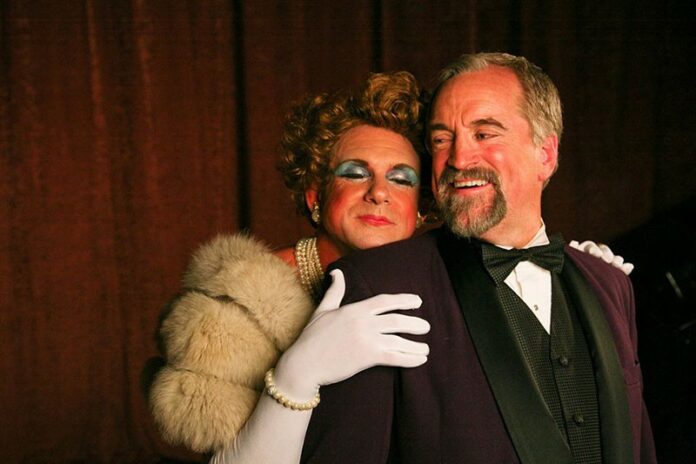Appearances can be deceiving. In Cinnabar Theater’s dramatically grounded, musically joyous production of La Cage Aux Folles, the opening anthem, “I Am What I Am,” is presented as a celebration of the art of female impersonation, a chorus of sexy, shimmying men in dresses singing the words, “I am what I am, and what I am is an illusion.”
As directed by Sheri Lee Miller, what’s often staged as an over-the-top spectacle of gender-bending farce and envelope-pushing comedy is revealed as the moving, honest, detailed love story that always existed below the wigs, high heels, feathers and glitter. By anchoring the comedy in clear, recognizable believability, and by keeping the motivations of the characters away from the trap of outsized caricature, Miller—who also serves as choreographer and costumer, with assistance in the latter from Clay David—establishes a rich, gradually escalating sense of emotional risk as these very real people bump, bruise, hurt, heal and, ultimately, love each other.
The nightclub of the title, La Cage Aux Folles—roughly translated as “Birds of a Feather”—is a cabaret on the French Riviera where the nightly stage show features a chorus of spectacular drag queens, with headliner ZaZa the most popular and famous gay performer on the Riviera. ZaZa is the stage name of Alban (Michael Van Why, spectacular, hilarious and moving), who for 20 years has raised a son with his longtime lover Georges, the boy’s biological father (an equally splendid Stephan Walsh, spot-on and marvelous). When their son, Jean-Michel (Kyle Stoner) arrives with news that he is engaged to the daughter of a French politician committed to shutting down all of the gay cabarets in the city, an escalating series of farcical plots is concocted to convince the in-laws that Alban and George are not what they really are.
What begins as two gay men pretending to be straight quickly becomes . . . well, something else entirely, as Alban and Georges improvise their way through a very long dinner party. Ultimately, each member of this affectionately eccentric family has a chance to rediscover and reaffirm his or herself—also rediscovering the love that holds them together—all while dancing their way through some pleasingly eye-popping song-and-dance numbers that show off Miller’s facility for staging everything from jazzy tap-dance numbers to a truly sultry tango.
The multiple Tony-winning 1983 musical was created by Jerry Herman and Harvey Fierstein, adapting a 1973 French stage play by Jean Poiret which itself inspired a series of popular French movies (along with the poorly received Americanized version The Birdcage, in 1996). The tuneful musical, with spirit-lifting songs that may end up battling in your head as the most likely to make you hum out loud, is often played as pure camp, a safe but unsatisfying approach to a show with so much built-in humanity and genuine heart.
The tight six-piece band, under the musical direction of Mary Chun, handles the difficult score with feisty aplomb.
Under Miller’s guidance, the cast meets the challenge of keeping everything real, while not missing the opportunities for bust-out-loud comedy and outrageous surprises. As Jean-Michel, Stoner handles the difficult task of making his character understandable and still likable, even when asking his parents to deny who they are in order to impress the father of the woman he loves. As Anne, Audrey Tatum is appealingly besotted with her fiancée, and as her parents, the stiffly straight-laced Monsieur and Madame Dindon, Stephen Dietz is delightfully prunish and Madeleine Ashe shows the carefree naughty-girl hiding beneath her conservative surface. Some of the show’s funniest moments come from James Pelican as Jacob, Alban’s faithful butler-maid-confidante, who dreams of getting a chance to step into the nightclub’s star-making spotlight. As the club’s beautifully bitchy chorus dancers, aka the Cagelles, J. Anthony Favalora, Jean-Paul Jones, Quinn Monroe, Valentina Osinski, and Zack Turner all shine. Ely Lichenstein, Clark Miller and Valentina Osinski all have their own moments, with Osinski also stepping in as one of the Cagelles.
The deceptively complex set, with hanging panels that instantly change the set from the front of the La Cage stage to backstage, is by David Lear, and Wayne Hovey does nice work with the mood-setting light design.
But the most dazzling onstage effects come from Alban and Georges, whose rocky but real relationship stands at the center of the whole undertaking. Georges’ affection for Alban is obvious, and when Alban takes his own turn with the song “I Am What I Am,” the wounded-but-proud emotional electricity Van Why generates as he sings “I am what I am, and what I am needs no excuses,” the moment is as complex and rich and raw as any speech by Arthur Miller or David Mamet.
La Cage Aux Folles is what it is—one of the best, most life-affirming musicals to appear onstage this season.
Rating (out of five): ★★★★½











